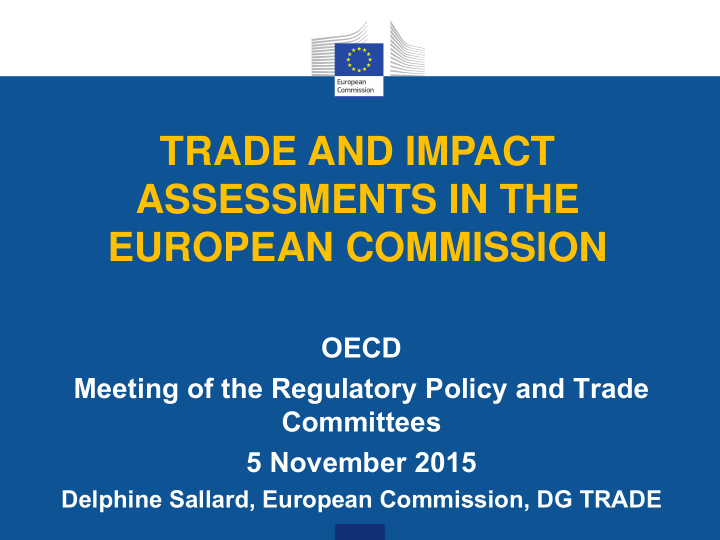



TRADE AND IMPACT ASSESSMENTS IN THE EUROPEAN COMMISSION OECD Meeting of the Regulatory Policy and Trade Committees 5 November 2015 Delphine Sallard, European Commission, DG TRADE
Part I: Impact assessments and evaluations are key elements of the trade policy cycle Up to four types of assessments and evaluations can be conducted by Impact Assessment Commission services during the life of a trade agreement: Preparation Ex Post Evaluation • An impact assessment at the initial Implementation design stage; Negotiations • A Sustainability Impact SIA Assessment (SIA) during the negotiations; • An economic assessment of the negotiated outcome after their conclusion; Signature Conclusion • An ex post evaluation, after their Economic assessment of the implementation. negotiated outcome 2
IAs, SIAs and ex-post evaluation : Their scope An integrated assessment. • addresses economic, social, human rights and environmental impacts; • direct and indirect impacts; • all parties significantly affected: businesses (with a special focus on SMEs), citizens, workers, consumers, public administrations, third country actors, developing countries, etc.; • should cover impacts in the EU, in the partner country(ies) and in relevant other countries. Complement each other. 3
IAs, SIAs, ex-post evaluations : How to assess impacts Quantitative Qualitative • Whenever feasible, impacts • Complementary should be assessed • Rigorous quantitatively • Thorough • Evidence-based Methodology Stakeholder Interservices Group Consultations • All Commission services with an interest participate, • Essential element of IAs, • Particularly those with SIAs and ex-post evaluations specific expertise 4
Part II: Assessment of the impact on trade and investment of future legislative or non-legislative EU action The Better Regulation Guidelines and Tools 1 . When designing policy options Discard any option clearly in breach of the EU ´ s international legal commitments. Always consider international standards, if they exist. 5
Part II: Assessment of the impact on trade and investment 2. When to analyse impact on trade and investment Significant impacts should be assessed qualitatively and, whenever possible, quantitatively. An indicative list of possible significant impacts; many related to trade and investment Eg: How will the option affect exports and imports out of and into the EU? Will the option affect regulatory convergence with third countries? Does it impact consumers' ability to benefit from international competition? What are the impacts on third countries with which the EU has preferential trade arrangements? Does the option affect goods or services that are produced or consumed by developing countries?........... 6
Assessment of the impact on trade and investment 3. How to analyse impact on trade and investment Screen the options against the EU's international legal commitments • To avoid possible inconsistencies with international obligations and agreements: a list of basic questions to systematically consider when designing the options Consider the impact on all economic agents • Consider sectors and firms throughout the whole value chain; analyse impact on EU exports; EU imports; EU firms dependent on inputs from firms based in third countries Consider the impact on investment flows and trade in services Consider the impact on trade partners • Regulatory convergence • Negative impact on international trade 7 • Developing countries, particularly LDCs
Assessment of the impact on trade and investment 4. When checking that the final proposal linked to the IA is fit for purpose and in line with better regulation principles: Without affecting the overall achievement of the objectives, is there scope to modify some of the legal provisions to reduce any potential negative impacts on international trade? 8
Thank you. 9
Recommend
More recommend